Recent Posts
Moving Check List
7/13/2023 (Permalink)
 New home awaiting its new owners!
New home awaiting its new owners!
Packing up your entire home and relocating can be extremely overwhelming. In order to make the move a smooth transition, there are a few things to check up on at your new home prior to moving in. Avoid any extra stress by checking off these five tasks for your new home.
Change the Locks
Changing the locks on all your doors is an important step to feeling safe in your new home. As kind as the previous owners may have been, it’s nice knowing there isn’t anyone out there but you that has a key to your home. It’s best to schedule this task before moving all your belongings in to avoid any time period of unsecured doors during the transition.
Deep Clean the House
Hopefully, the previous owners took care of cleaning and preparing the house when they first moved out, but there are some areas to check on just to be sure the place is in pristine condition. It’s easiest to clean the hard-to-reach places before you move in and there aren’t any objects in the way. Some areas to deep clean might include inside cupboards, the washer and dryer, fridge, oven, stove, and dishwasher.
Inspect for Mold
The last thing you need is to settle into your new home only to discover it has a mold issue. The minimum you should do is at least inspect for leaks, odors, or visible signs of mold throughout the house. However, now is the prime time to schedule a mold inspection and cleanup to detect the air quality of your home and find any hidden mold.
Check Smoke and Carbon Monoxide Detectors
Speaking of air quality, make sure to check the carbon monoxide detector and smoke alarms throughout the house. It’s a relief knowing that your home is equipped with up-to-date and working monitors for you and your family’s safety. If the house doesn’t have a carbon monoxide detector yet, then now is the perfect time to purchase and install one before moving in.
Inspect the Plumbing
Make sure that the plumbing is in mint condition before moving in rather than discovering it too late. Check for leaks and any signs of water damage, and make any appointments you need to fix leaks and issues. This will not only make things run smoother, but it will also save your water bill. While you’re at it, take a look at the water heater as well. Now is a good time to flush your water heater of sediment and check if it has a water softener as well.
There is already a long list of to-dos when it comes to moving out of your house, but many things go overlooked and forgotten when it comes to the new house. Give careful consideration to the different tasks listed to make your new major change a little easier. You will feel confident and relieved moving into your new home knowing you’ve changed the locks, deep cleaned the place, inspected for mold, checked the air and alarms, and inspected the plumbing.
Source: https://www.hewnandhammered.com/hewn/2019/10/new-home-move-in-checklist.html
As a Community, We Are Better Together
7/13/2023 (Permalink)
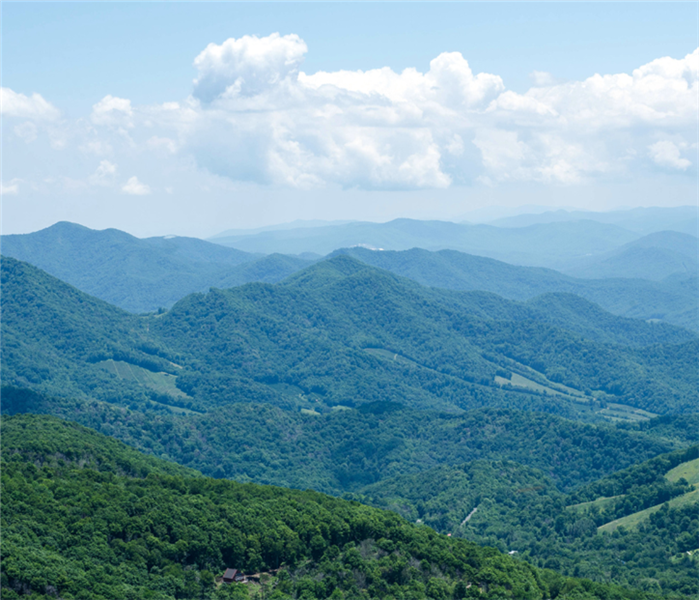 The beautiful mountains of East Tennessee.
The beautiful mountains of East Tennessee.
Our little community may be small in size but large in impact and culture. Our small but thriving areas make living in East Tennessee possibly one of the greatest places in America to live.
One great thing about our little community is that we love big. We stand behind one another in good times and in bad. We support and encourage one another. When one part of our community is struggling or faces disaster, we come alongside them as one unit in helping restore them to their previous state.
At SERVPRO, we are proud of our community. We are privileged to come alongside it and to serve the people that live and do business inside the county lines. We are sure that there are tons of other small towns and communities like ours, but we wouldn't trade ours for the world.
We hope that our community knows that if they face fire, water, mold, or storm damage, that we will be there fast to get them back on their feet in no time. But, the best part is, we are better together!
Here Are Tips on How to Stop Leaking Toilets
7/13/2023 (Permalink)
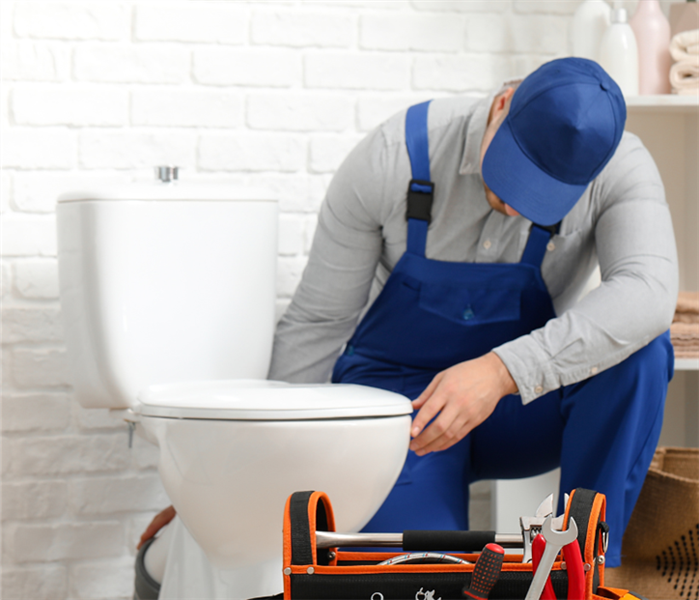 Man fixing toilet.
Man fixing toilet.
Got a leaky toilet? Believe it or not, it’s a common problem. Continue reading to find out the likeliest causes and the easiest ways to remedy the situation.
First, some of the washers between the bowl and tank may have failed. Shut off the supply valve, empty the tank with a flush, then remove the nuts, bolts, and washers from the underside of the tank. Lift the tank, position it on its side, and see if the washers need replacing.
Another culprit may be faulty fasteners securing the fill valve and ballcock to the bottom of the tank. Before you replace those parts, however, first try simply tightening the nuts and bolts holding them in place—that often solves the problem.
On the other hand, if the leak seems to be coming from the base of the tank, chances are the wax ring that seals the toilet to the floor has failed. Replacing the wax ring is a much bigger job, since it involves removing the entire toilet from its base. If you decide to replace the wax ring yourself—preferably with a friend to help with the lifting—take the extra step of also replacing any bolts that show signs of corrosion. And, once you have the toilet back in place, don’t forget to add a bead of caulk around the base.
Source: https://www.bobvila.com/articles/toilet-leaking/#.Wnxo75M-e35
Here Are Tips on How to Stop Leaking Toilets
7/13/2023 (Permalink)
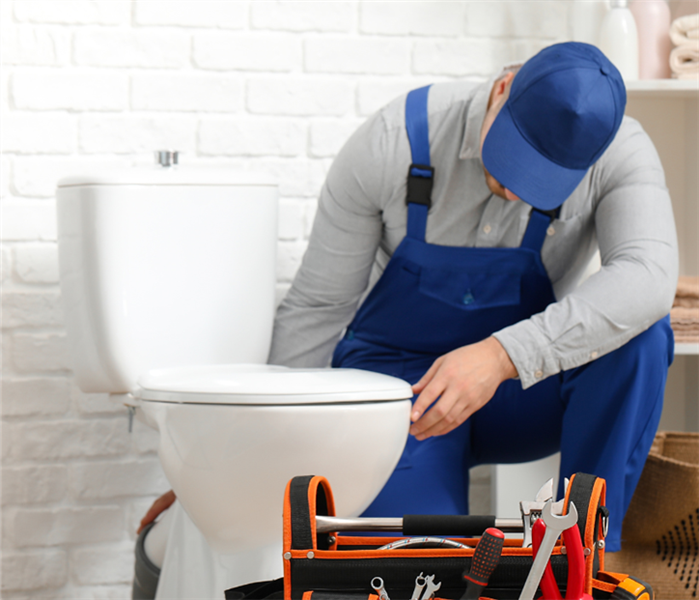 Man fixing toilet.
Man fixing toilet.
Got a leaky toilet? Believe it or not, it’s a common problem. Continue reading to find out the likeliest causes and the easiest ways to remedy the situation.
First, some of the washers between the bowl and tank may have failed. Shut off the supply valve, empty the tank with a flush, then remove the nuts, bolts, and washers from the underside of the tank. Lift the tank, position it on its side, and see if the washers need replacing.
Another culprit may be faulty fasteners securing the fill valve and ballcock to the bottom of the tank. Before you replace those parts, however, first try simply tightening the nuts and bolts holding them in place—that often solves the problem.
On the other hand, if the leak seems to be coming from the base of the tank, chances are the wax ring that seals the toilet to the floor has failed. Replacing the wax ring is a much bigger job, since it involves removing the entire toilet from its base. If you decide to replace the wax ring yourself—preferably with a friend to help with the lifting—take the extra step of also replacing any bolts that show signs of corrosion. And, once you have the toilet back in place, don’t forget to add a bead of caulk around the base.
Source: https://www.bobvila.com/articles/toilet-leaking/#.Wnxo75M-e35
With These 7 Steps Prepare Your Plumbing for Winter
7/13/2023 (Permalink)
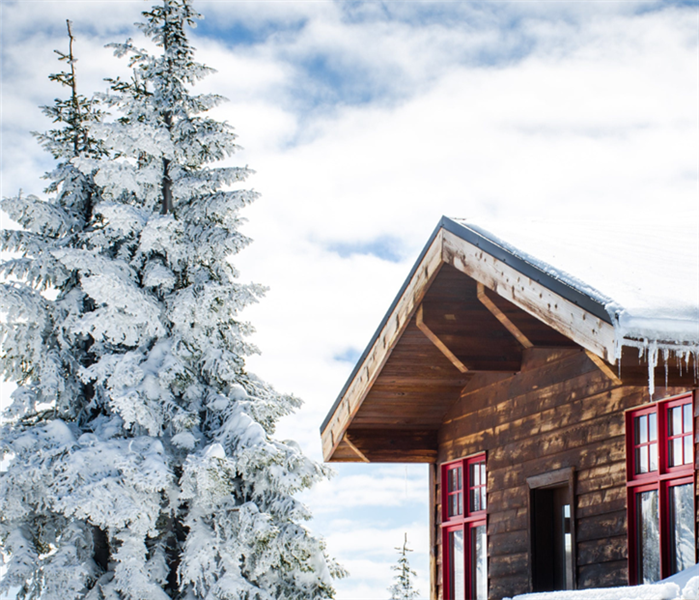 Cabin house frozen in winter.
Cabin house frozen in winter.
Simple Steps to Prepare Your Plumbing for Winter
Have you prepared your plumbing for winter? Damage caused from burst pipes can cost you thousands, of dollars. Not all damage is covered by homeowner’s insurance. We want to make sure you know some simple steps to get you prepared. Follow these 7 simple steps to get off to a great start. Find yourself in a bind? Brogdon Plumbing is here to help! Give us a call.
- Prepare your outdoor faucets. Remove and drain your water hoses and store them indoors before the first freeze.
- Fix leaks now. Inspect your pipes and have any/all leaks repaired.
- Wrap any pipes in unheated areas of the home. This is crucial, for mobile homes. Visit the hardware store and grab some heat tape and/or pipe insulation. There are also easy to install kits, that include a thermostat. These kits can help you in the event of frigid temps for long periods. Don’t hesitate to ask an employee for recommendations. Protecting the pipes in your home, from low temperatures is THE single most important thing that you can do.
- Tune up your water heater. You will want to drain and maintain your water heater at this time every year. It’s a little harder to do yourself but we are glad to help! Just give us a call.
- Service your furnace. Make sure you have clean filters and call a professional to help with major repairs. Heat means pipes could freeze. If they do, call us!
- Selling your home or heading south for winter? Shut off the water, in your home, completely and consider contacting us to drain your pipes. Any water left in your pipes is at risk of freezing and causing pipes to bust. If nobody is home, the damage can be widespread and severe. Don’t take chances.
- Call Brogdon plumbing! If you have questions or concerns, contact us for help. We will gladly help with your winter pipe preparations!
What else can you do to prepare your plumbing for winter? Share your personal tips/tricks with us.
Source: http://www.brogdonplumbing.com/prepare-plumbing-for-winter/
What You Should Do When a Tree Falls on Your Home
7/13/2023 (Permalink)
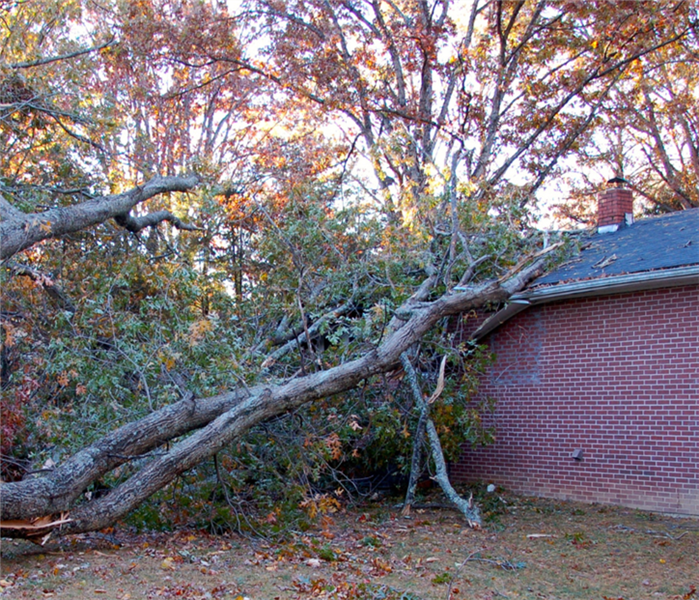 What To Do When A Tree Falls On Your Home
What To Do When A Tree Falls On Your Home
According to OSHA (the Occupational Safety and Health Administration), more people are killed by falling trees every year (100+) than are killed by sharks (about 4-7 per year).
Falling trees kill or injure more people than lightning. Although the numbers of tree fall fatalities are relatively low compared with other fatalities, the numbers for property damage from falling trees is much higher, ranging in the hundreds of thousands. According to the National Storm Damage Center, falling trees are the main causes of roof damage, costing more than $1 billion in property damage each year. So, chances are if you are a homeowner with lots of trees in your yard, you may encounter tree damage of some kind in your lifetime and in that situation, you will need to know what to do if a tree falls on your home:
- If you’re in the house when a tree falls, leave the house and the property as soon as possible. Beware of downed electrical lines, and if you have gas lines, do not use your cell phone to call for help until you are away from the house. Use the safest route possible to get away from the house.
- Call 911 or emergency services. They will send fire or appropriate responders to ensure the house is safe. If anyone has been injured or killed, let the dispatcher know this when you call. Remain at the scene unless you are injured. Seek medical care or wait for an ambulance if you have been injured.
- Call your insurance company as soon as possible so they can agree to cover any emergency costs, removal or other details covered in your homeowner’s policy. If your tree has fallen on your neighbor’s property, your neighbor will need to make a claim on their insurance policy, but your insurance company should be aware of the damage as well.
- Contact a roofing contractor, tree surgeon, tree removal company, builder or any other home professional to examine any damage, to remove the tree and secure the home so there is no additional damage to your property or possessions. Even if the tree misses the house, tree roots can extend under a property, causing damage to the foundation. So, have your builder or contractor check inside the house for cracks in the drywall, or the outside for cracks in the brickwork. Lowes’ experts say, “Don’t attempt to deal with the tree removal or roof repair yourself. Even if the fallen branches or tree seems small, you never know the extent of the storm damage or if the framework or structural integrity if your home has been compromised.”
- If you are unable to live in the house during repairs, make sure any damaged areas are secured to prevent looting and theft. Put valuables in temporary storage, and board up broken windows, holes in the wall etc.
Once the tree has been dealt with, what steps can you take to ensure it doesn’t happen again?
Make sure your trees are healthy
Other than raking leaves, building treehouses, or picking up fallen branches, twigs and debris, most homeowners don’t think about their trees very often. Even fewer know the signs of an unhealthy, dying, or dead branch or tree. Here a few signs from RTEC Treecare, one of the companies that take care of the trees at the mall in Washington, DC to pay attention to:
- Large branches attached with tight, V-shaped forks. These branches are prone to failure and may need to be lightened or removed.
- Cracks in the trunk of the tree or in major limbs
- Fungi growing from the base of your tree or under its canopy. This could be a sign of root decay.
- Branches that are pointing/hanging downwards these damaged branches can easily fall during storms.
- Partially attached limbs hung up in the high branches that could fall.
- Large cavities in the tree trunk.
- Wires in contact with tree branches.
Other things you can do to ensure you and your family are safe from tree falls:
- Have an arborist inspect your trees every year, or whenever there’s been an injury or damage to a tree – such as a lightning strike, hit by a motor vehicle, or a pest infestation.
- Do preventative pruning, and ask your neighbors to do the same. Preventative pruning reduces wind resistance and removes dead branches. This reduces the risk of the tree or the tree’s limbs snapping under the force of wind gusts.
- Make sure your trees are mulched correctly if you mulch them. Mulch protects the root system of the tree and allows water and nutrients to drain down through the soil to the roots. This keeps the root system healthy which helps the tree stay strong during storms. Unhealthy root systems can lead to trees uprooting and snapping in heavy winds.
- Wrap your young trees to prevent sunscald. Sunscald is winter damage that is commonly seen on young trees, newly planted trees, and thin-barked trees (cherry, crabapple, honey locust, linden, maple, mountain ash, plum). Sunscald causes the tree bark to dry and crack.
Legal issues regarding who pays for damages or home repairs etc. to your house from a falling tree in your yard, or from a neighbor’s yard, vary greatly from state-to-state, county to county and insurer to insurer. It’s best to talk to your insurance agent before anything happens to determine if you are covered in the event of a tree fall.
Source: https://www.homes.com/blog/2017/12/tree-falls-house/
What You Should Do When a Tree Falls on Your Home
7/13/2023 (Permalink)
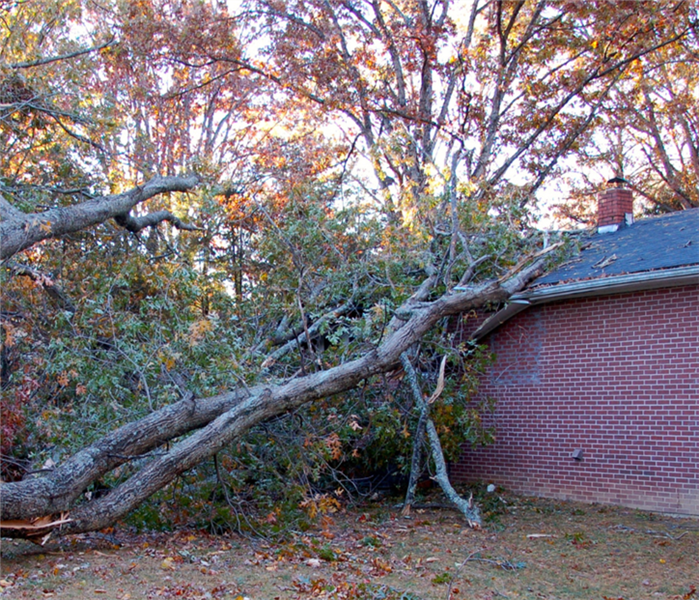 What To Do When A Tree Falls On Your Home
What To Do When A Tree Falls On Your Home
According to OSHA (the Occupational Safety and Health Administration), more people are killed by falling trees every year (100+) than are killed by sharks (about 4-7 per year).
Falling trees kill or injure more people than lightning. Although the numbers of tree fall fatalities are relatively low compared with other fatalities, the numbers for property damage from falling trees is much higher, ranging in the hundreds of thousands. According to the National Storm Damage Center, falling trees are the main causes of roof damage, costing more than $1 billion in property damage each year. So, chances are if you are a homeowner with lots of trees in your yard, you may encounter tree damage of some kind in your lifetime and in that situation, you will need to know what to do if a tree falls on your home:
- If you’re in the house when a tree falls, leave the house and the property as soon as possible. Beware of downed electrical lines, and if you have gas lines, do not use your cell phone to call for help until you are away from the house. Use the safest route possible to get away from the house.
- Call 911 or emergency services. They will send fire or appropriate responders to ensure the house is safe. If anyone has been injured or killed, let the dispatcher know this when you call. Remain at the scene unless you are injured. Seek medical care or wait for an ambulance if you have been injured.
- Call your insurance company as soon as possible so they can agree to cover any emergency costs, removal or other details covered in your homeowner’s policy. If your tree has fallen on your neighbor’s property, your neighbor will need to make a claim on their insurance policy, but your insurance company should be aware of the damage as well.
- Contact a roofing contractor, tree surgeon, tree removal company, builder or any other home professional to examine any damage, to remove the tree and secure the home so there is no additional damage to your property or possessions. Even if the tree misses the house, tree roots can extend under a property, causing damage to the foundation. So, have your builder or contractor check inside the house for cracks in the drywall, or the outside for cracks in the brickwork. Lowes’ experts say, “Don’t attempt to deal with the tree removal or roof repair yourself. Even if the fallen branches or tree seems small, you never know the extent of the storm damage or if the framework or structural integrity if your home has been compromised.”
- If you are unable to live in the house during repairs, make sure any damaged areas are secured to prevent looting and theft. Put valuables in temporary storage, and board up broken windows, holes in the wall etc.
Once the tree has been dealt with, what steps can you take to ensure it doesn’t happen again?
Make sure your trees are healthy
Other than raking leaves, building treehouses, or picking up fallen branches, twigs and debris, most homeowners don’t think about their trees very often. Even fewer know the signs of an unhealthy, dying, or dead branch or tree. Here a few signs from RTEC Treecare, one of the companies that take care of the trees at the mall in Washington, DC to pay attention to:
- Large branches attached with tight, V-shaped forks. These branches are prone to failure and may need to be lightened or removed.
- Cracks in the trunk of the tree or in major limbs
- Fungi growing from the base of your tree or under its canopy. This could be a sign of root decay.
- Branches that are pointing/hanging downwards these damaged branches can easily fall during storms.
- Partially attached limbs hung up in the high branches that could fall.
- Large cavities in the tree trunk.
- Wires in contact with tree branches.
Other things you can do to ensure you and your family are safe from tree falls:
- Have an arborist inspect your trees every year, or whenever there’s been an injury or damage to a tree – such as a lightning strike, hit by a motor vehicle, or a pest infestation.
- Do preventative pruning, and ask your neighbors to do the same. Preventative pruning reduces wind resistance and removes dead branches. This reduces the risk of the tree or the tree’s limbs snapping under the force of wind gusts.
- Make sure your trees are mulched correctly if you mulch them. Mulch protects the root system of the tree and allows water and nutrients to drain down through the soil to the roots. This keeps the root system healthy which helps the tree stay strong during storms. Unhealthy root systems can lead to trees uprooting and snapping in heavy winds.
- Wrap your young trees to prevent sunscald. Sunscald is winter damage that is commonly seen on young trees, newly planted trees, and thin-barked trees (cherry, crabapple, honey locust, linden, maple, mountain ash, plum). Sunscald causes the tree bark to dry and crack.
Legal issues regarding who pays for damages or home repairs etc. to your house from a falling tree in your yard, or from a neighbor’s yard, vary greatly from state-to-state, county to county and insurer to insurer. It’s best to talk to your insurance agent before anything happens to determine if you are covered in the event of a tree fall.
Source: https://www.homes.com/blog/2017/12/tree-falls-house/
Prepare for Winter Storms with This Safety Approach
7/13/2023 (Permalink)
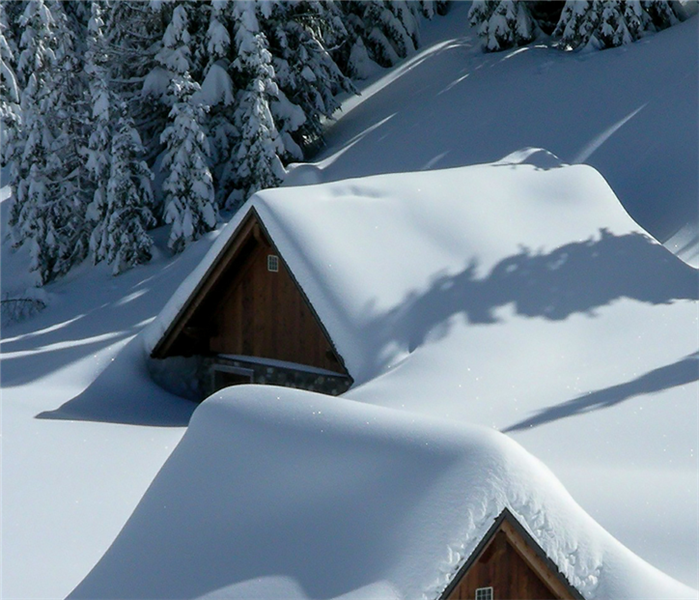 Houses in a Winter Storm
Houses in a Winter Storm
Each year, hundreds of Americans are injured or killed by exposure to cold, vehicle accidents on wintry roads, and fires caused by the improper use of heaters. Learn what to do to keep your loved ones safe during blizzards and other winter storms!
Take immediate precautions if you hear these words on the news:
- Winter Storm WARNING: Life-threatening, severe winter conditions have begun or will begin within 24 hours.
- Blizzard WARNING: Sustained winds or frequent gusts of 35 miles per hour or greater, plus considerable falling or blowing snow reducing visibility to less than a quarter mile, expected to prevail for three hours or longer.
More winter storm words to listen for:
- WIND CHILL Temperature: How cold people and animals feel when outside. As wind increases, heat is carried away from your body at a faster rate, driving down your body temperature and making you feel much colder. The wind chill temperature is not the actual temperature but rather how wind and cold feel on exposed skin.
- Winter Storm OUTLOOK: Winter storm conditions possible in the next two to five days. Stay tuned to local media for updates.
- Winter Storm WATCH: Winter storm conditions possible within the next 36 to 48 hours. Review your winter storm plans and stay informed about weather conditions.
- Winter Weather ADVISORY: Winter weather conditions expected to cause significant inconveniences and may be hazardous but not life-threatening if you are cautious.
Before
VIDEO: 3 Easy Steps to Prepare
Prepare in Advance
Be sure you’re Red Cross Ready. That means:
How to Prepare for a Winter Storm
Protecting your family
- Talk with your family about what to do if a winter storm watch or warning is issued. Discussing winter storms ahead of time helps reduce fear, particularly for young children.
- Have your vehicle winterized before the winter storm season to decrease your chance of being stranded in cold weather.
- Have a mechanic check your battery, antifreeze, wipers and windshield washer fluid, ignition system, thermostat, lights, flashing hazard lights, exhaust system, heater, brakes, defroster, and oil.
- Install good winter tires with adequate tread. All-weather radials are usually adequate but some jurisdictions require vehicles to be equipped with chains or snow tires with studs.
- Keep in your vehicle:
- A windshield scraper and small broom
- A small sack of sand for generating traction under wheels and a set of tire chains or traction mats
- Matches in a waterproof container
- A brightly colored (preferably red) cloth to tie to the antenna
- An emergency supply kit, including warm clothing.
- Keep your vehicle’s gas tank full so you can leave right away in an emergency and to keep the fuel line from freezing.
- Keep a supply of non-clumping kitty litter to make walkways and steps less slippery.
- Service snow removal equipment before the winter storm season and maintain it in good working order.
- Keep handy a warm coat, gloves or mittens, hat, water-resistant boots, and extra blankets and warm clothing for each member of the household.
Protecting your pets & animals
- Bring your companion animals indoors.
- Ensure that you have supplies for clean up for your companion animals, particularly if they are used to eliminating outdoors (large plastic bags, paper towels, and extra cat litter).
- Create a place where your other animals can be comfortable in severe winter weather:
- Horses and livestock should have a shelter where they can be protected from wind, snow, ice, and rain.
- Grazing animals should have access to a protected supply of food and non-frozen water.
- Be aware of the potential for flooding when snow and ice melt and be sure that your animals have access to high ground that is not impeded by fencing or other barriers. You may not be able to get to them in time to relocate them in the event of flooding.
- Ensure that any outbuildings that house or shelter animals can withstand wind and heavy snow and ice.
- Install snow fences in rural areas to reduce drifting snow on roads and paths, which could block access to homes, barns, and animals' feed and water.
Protecting your home
- Learn how to protect pipes from freezing
- Make sure your home heating sources are installed according to local codes and permit requirements and are clean and in working order.
- Make sure your home is properly insulated. Caulk and weather-strip doors and windowsills to keep cold air out.
- Install storm windows or cover windows with plastic from the inside to provide an extra layer of insulation to keep cold air out.
- Consider buying emergency heating equipment, such as a wood- or coal-burning stove or an electric or kerosene heater.
- Stoves must be properly vented and in good working order. Dispose of ashes safely. Keep a supply of wood or coal on hand.
- Electric space heaters, either portable or fixed, must be certified by an independent testing laboratory. Plug a heater directly into the wall socket rather than using an extension cord and unplug it when it is not in use.
- Use a kerosene heater only if permitted by law in your area; check with your local fire department. Use only the correct fuel for your unit. Properly ventilate the area. Refuel the unit outdoors only, and only when the unit is cool. Follow all of the manufacturer's instructions.
- Consider storing sufficient heating fuel. Regular fuel sources may be cut off. Be cautious of fire hazards when storing any type of fuel.
- If you have a fireplace, consider keeping a supply of firewood or coal. Be sure the fireplace is properly vented and in good working order and that you dispose of ashes safely.
- Consider installing a portable generator, following our safety tips to avoid home fires and carbon monoxide poisoning
- Consider purchasing flood insurance, if you live in a flood-prone area, to cover possible flood damage that may occur during the spring thaw. Homeowners' policies do not cover damage from floods. Ask your insurance agent about the National Flood Insurance Program (NFIP) if you are at risk. More information on NFIP is available at www.fema.gov/nfip.
Right before a blizzard / winter stormIf you do nothing else:
- Listen to local area radio, NOAA radio or TV stations for the latest information and updates.
- Be prepared to evacuate if you lose power or heat and know your routes and destinations. Find a local emergency shelter.
- Check emergency kit and replenish any items missing or in short supply, especially medications and medical supplies. Keep it nearby.
- Be sure you have ample heating fuel.
- If you have alternative heating sources, such as fireplaces, wood- or coal-burning stoves, or space heaters, be sure they are clean and in working order.
- Check that your fire extinguisher(s) is in good working order, and replace it if necessary.
- Bring your companion animals inside and ensure that your horses and livestock have blankets if appropriate and unimpeded access to shelter, food, and non-frozen water.
During
Stay Safe During a Winter Storm
Staying Safe During a Winter Storm or Blizzard
- Stay indoors and wear warm clothes. Layers of loose-fitting, lightweight, warm clothing will keep you warmer than a bulky sweater. If you feel too warm, remove layers to avoid sweating; if you feel chilled, add layers.
- Listen to a local station on battery-powered radio or television or to NOAA Weather Radio for updated emergency information.
- Bring your companion animals inside before the storm begins.
- Move other animals to sheltered areas with a supply of non-frozen water. Most animal deaths in winter storms are caused by dehydration.
- Eat regularly. Food provides the body with energy for producing its own heat.
- Keep the body replenished with fluids to prevent dehydration. Drink liquids such as warm broth or juice. Avoid caffeine and alcohol. Caffeine, a stimulant, accelerates the symptoms of hypothermia. Alcohol, such as brandy, is a depressant and hastens the effects of cold on the body. Alcohol also slows circulation and can make you less aware of the effects of cold. Both caffeine and alcohol can cause dehydration.
- Conserve fuel. Winter storms can last for several days, placing great demand on electric, gas, and other fuel distribution systems (fuel oil, propane, etc.). Lower the thermostat to 65° F (18° C) during the day and to 55° F (13° C) at night. Close off unused rooms, and stuff towels or rags in cracks under the doors. Cover the windows at night.
- Check on relatives, neighbors, and friends, particularly if they are elderly or if they live alone.
Staying Safe OutsideIf you must go outside, protect yourself from winter storm hazards:
- Wear layered clothing, mittens or gloves, and a hat. Outer garments should be tightly woven and water repellent. Mittens or gloves and a hat will prevent the loss of body heat.
- Cover your mouth to protect your lungs from severely cold air. Avoid taking deep breaths; minimize talking.
- Watch for signs of hypothermia and frostbite.
- Keep dry. Change wet clothing frequently to prevent a loss of body heat. Wet clothing loses much of its insulating value and transmits heat rapidly away from the body.
- Stretch before you go out. If you go out to shovel snow, do a few stretching exercises to warm up your body. This will reduce your chances of muscle injury.
- Avoid overexertion, such as shoveling heavy snow, pushing a vehicle, or walking in deep snow. The strain from the cold and the hard labor may cause a heart attack. Sweating could lead to a chill and hypothermia.
- Walk carefully on snowy, icy sidewalks. Slips and falls occur frequently in winter weather, resulting in painful and sometimes disabling injuries.
- If you must go out during a winter storm, use public transportation if possible. About 70 percent of winter deaths related to ice and snow occur in automobiles.
Driving in Winter Conditions
- Check your vehicle emergency supplies kit and replenish it if necessary.
- Bring enough of the following for each person:
- Blankets or sleeping bags
- Rain gear, extra sets of dry clothing, mittens, socks, and wool hats
- Newspapers for insulation
- Plastic bags for sanitation
- Canned fruit, nuts, and high energy snacks (Include a non-electric can opener if necessary)
- Warm broth in a thermos and several bottles of water
- Keep a cell phone or two-way radio with you. Make sure the battery is charged.
- Plan to travel during daylight and, if possible, take at least one other person with you.
- Let someone know your destination, your route, and when you expect to arrive. If your vehicle gets stuck along the way, help can be sent along your predetermined route.
- Before leaving, listen to weather reports for your area and the areas you will be passing through, or call the state highway patrol for the latest road conditions.
- Be on the lookout for sleet, freezing rain, freezing drizzle, and dense fog, which can make driving very hazardous
If You Become Stranded
- Stay in the vehicle and wait for help. Do not leave the vehicle to search for assistance unless help is visible within 100 yards (91 meters). You can quickly become disoriented and confused in blowing snow.
- Display a trouble sign to indicate you need help. Hang a brightly colored cloth (preferably red) on the radio antenna and raise the hood after snow stops falling.
- Run the engine occasionally to keep warm. Turn on the engine for about 10 minutes each hour (or five minutes every half hour). Running the engine for only short periods reduces the risk of carbon monoxide poisoning and conserves fuel. Use the heater while the engine is running. Keep the exhaust pipe clear of snow, and slightly open a downwind window for ventilation.
- Leave the overhead light on when the engine is running so that you can be seen.
- Do light exercises to keep up circulation. Clap your hands and move your arms and legs occasionally. Try not to stay in one position for too long.
- If more than one person is in the vehicle, take turns sleeping. If you are not awakened periodically to increase body temperature and circulation, you can freeze to death.
- Huddle together for warmth. Use newspapers, maps, and even the removable floor mats for added insulation. Layering items will help trap more body heat.
- Watch for signs of frostbite and hypothermia. Severe cold can cause numbness, making you unaware of possible danger.
- Drink fluids to avoid dehydration, which can make you more susceptible to the ill effects of cold and to heart attacks.
- Avoid overexertion. Cold weather puts an added strain on the heart. Shoveling snow or pushing a vehicle can bring on a heart attack or make other medical conditions worse.
After
After a Winter Storm
- Continue listening to local news or a NOAA Weather Radio for updated information and instructions. Access to some parts of the community may be limited or roads may be blocked.
- Help people who require special assistance—infants, elderly people, those without transportation, large families who may need additional help in an emergency situation, people with disabilities, and the people who care for them.
- Avoid driving and other travel until conditions have improved.
- Avoid overexertion. Heart attacks from shoveling heavy snow are a leading cause of death during the winter.
- Check on your animals and ensure that their access to food and water is unimpeded by drifted snow, ice, or other obstacles.
- If you are using a portable generator, take precautions against carbon monoxide poisoning, electrocution and fire.
Identifying & Treating Frostbite and Hypothermia
Frostbite and hypothermia are cold-related emergencies that may quickly become life or limb threatening.
Take these steps to avoid frostbite and hypothermia:
- Be aware of the wind chill. Dress appropriately and avoid staying in the cold too long. Wear a hat and gloves when appropriate with layers of clothing. Avoid unnecessary exposure of any part of the body to the cold.
- Drink plenty of warm fluids or warm water but avoid caffeine and alcohol. Stay active to maintain body heat.
- Take frequent breaks from the cold.
- Get out of the cold immediately if the signals of hypothermia or frostbite appear.
Frostbite
Frostbite is the freezing of a specific body part such as fingers, toes, the nose or earlobes.
Signs of frostbite:
- Lack of feeling in the affected area
- Skin that appears waxy, is cold to the touch, or is discolored (flushed, white or gray, yellow or blue)
What to do for frostbite:
- Move the person to a warm place
- Handle the area gently; never rub the affected area
- Warm gently by soaking the affected area in warm water (100–105 degrees F) until it appears red and feels warm
- Loosely bandage the area with dry, sterile dressings
- If the person’s fingers or toes are frostbitten, place dry, sterile gauze between them to keep them separated
- Avoid breaking any blisters
- Do not allow the affected area to refreeze
- Seek professional medical care as soon as possible
Hypothermia
Hypothermia is the cooling of the body caused by the failure of the body’s warming system. The goals of first aid are to restore normal body temperature and to care for any conditions while waiting for EMS personnel.
Signs of hypothermia:
- Shivering
- Numbness or weakness
- Glassy stare
- Apathy or impaired judgment
- Loss of consciousness
What to do for hypothermia:
- CALL 9-1-1 or the local emergency number
- Gently move the person to a warm place
- Monitor breathing and circulation
- Give rescue breathing and CPR if needed
- Remove any wet clothing and dry the person
- Warm the person slowly by wrapping in blankets or by putting dry clothing on the person.
- Hot water bottles and chemical hot packs may be used when first wrapped in a towel or blanket before applying. Do not warm the person too quickly, such as by immersing him or her in warm water.
- Warm the core first (trunk, abdomen), not the extremities (hands, feet).
Recovering After a Winter Storm
Once you are physically safe, take time to ensure your family’s emotional and financial well-being.
Source: http://www.redcross.org/get-help/how-to-prepare-for-emergencies/types-of-emergencies/winter-storm#About
10 Common Causes for House Fires
7/13/2023 (Permalink)
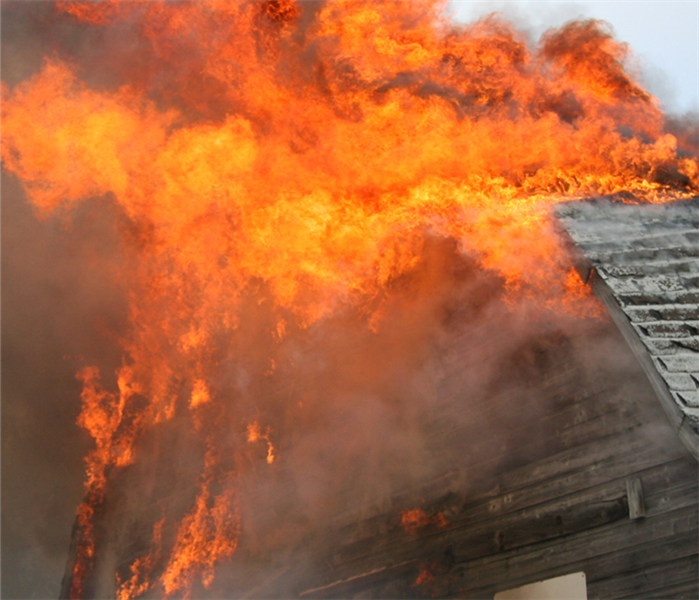 Winter house fire.
Winter house fire.
A house can easily catch fire from the misuse of appliances and heating equipment to smoking in bedrooms. In Australia’s hot summer months, temperatures can soar past 40°C and teamed with a dry climate, conditions are ideal for fires to break out.
However you can take measures to avoid fire in home and ensure the safety of your family. Below are some of the most common causes of house fires, and some tips to take precautions.
1. Cooking Equipment
Pots and pans can overheat and cause a fire very easily if the person cooking gets distracted and leaves cooking unattended. Always stay in the room, or ask someone to watch your food, when cooking on hotplates.
2. Heating
Keep portable heaters at least one metre away from anything that could easily catch fire such as furniture, curtains, laundry, clothes and even yourself. If you have a furnace, get it inspected once a year to make sure it is working to safety standards.
3. Smoking in bedrooms
Bedrooms are best to be kept off limits for smoking. A cigarette that is not put out properly can cause a flame, as the butt may stay alit for a few hours. It could burst into flames if it came into contact with flammable materials, such as furniture. Did you know that fires started in the bedroom or lounge make up 73% of all house fire fatalities?¹
4. Electrical Equipment
An electrical appliance, such as a toaster can start a fire if it is faulty or has a frayed cord. A power point that is overloaded with double adapter plugs can cause a fire from an overuse of electricity. A power point extension cord can also be a fire hazard if not used appropriately. Double check the appliances and power points in your home.
5. Candles
Candles look and smell pretty, but if left unattended they can cause a room to easily burst into flames. Keep candles away from any obviously flammable items such as books and tissue boxes. Always blow a candle out before leaving a room. Did you know that in Perth last year 34 house fires started as a result of candles?²
6. Curious Children
Kids can cause a fire out of curiosity, to see what would happen if they set fire to an object. Keep any matches or lighters out of reach of children, to avoid any curiosity turned disaster. Install a smoke alarm in your child’s room and practice a home escape plan with your children and family in case there was a fire. Teach kids understand the “stop, drop, cover and roll” drill as well as knowing their address if they needed to call 000.
7. Faulty Wiring
Homes with inadequate wiring can cause fires from electrical hazards. Some signs to see if you’ve bad wiring are: 1) Lights dim if you use another appliance; 2) For an appliance to work, you have to disconnect another; 3) Fuses blow or trip the circuit frequently. Have a licenced electrician come and inspect you house, or contact your landlord if you have any of the above occurrences.
8. Barbeques
Barbeques are great for an outdoor meal, but should always be used away from the home, tablecloths or any plants and tree branches. Keep BBQs regularly maintained and cleaned with soapy water and clean any removable parts. Check the gas bottle for any leaks before you use it each time.
9. Flammable Liquids
If you have any flammable liquids in the home or garage such as petrol, kerosene or methylated spirits, keep them away from heat sources and check the label before storing. Be careful when pouring these liquids.
10. Lighting
Lamp shades and light fittings can build up heat if they are very close to light globes. Check around the house to make sure. Lamp bases can become a hazard if they are able to be knocked over easily, and so should be removed if they are. Check that down lights are insulated from wood panelling or ceiling timbers.
The above tips are a good guide to avoiding a fire in your home. However it’s a good idea to protect yourself with adequate home and content insurance, cover to ensure you are covered in the unlikely event a fire were to happen.
Source: https://www.realinsurance.com.au/news-views/the-most-common-causes-of-house-fires
How to Prevent Winter Fires from Occurring
7/13/2023 (Permalink)
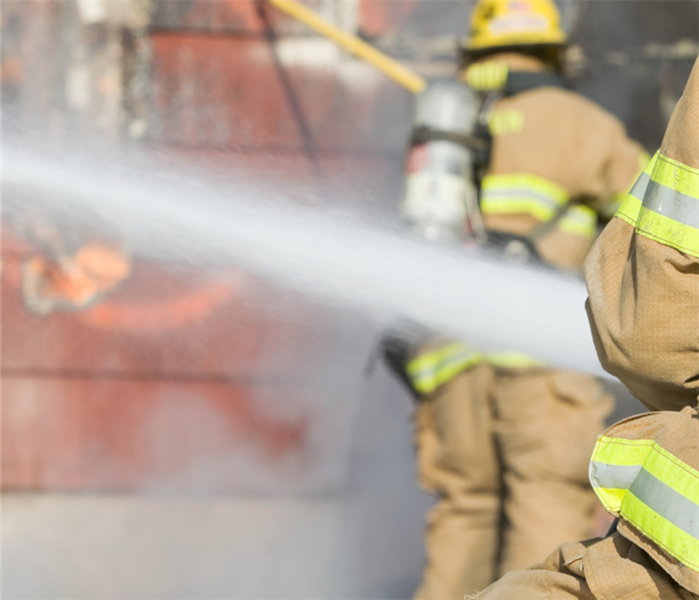 Put an end to winter fires.
Put an end to winter fires.
Heating, holiday decorations, winter storms and candles all contribute to an increased risk of fire during the winter months.
NFPA and the United States Fire Administration (USFA) are teaming up to help reduce your risk to winter fires and other hazards, including carbon monoxide and electrical fires. Learn more about these specific elements of winter fire safety to help keep you safe this winter.
Heating
Heating is the second leading cause of U.S. home fires, deaths and injuries. December, January and February are the peak months for heating fires. Space heaters are the type of equipment most often involved in home heating equipment fires, figuring in two of every five fires (40%).
Carbon Monoxide
Often called the invisible killer, carbon monoxide (CO) is an odorless, colorless gas created when fuels such as gasoline, wood, coal, propane, etc. do not burn. In the home, heating and cooking equipment that burn fuel are potential sources of CO. Carbon Monoxide incidents are more common during the winter months, and in residential properties.
Winter storms
Most of the U.S. is at risk for winter storms, which can cause dangerous and sometimes life-threatening conditions. Blinding wind-driven snow, extreme cold, icy road conditions, downed trees and power lines can all wreak havoc on our daily schedules. Home fires occur more in the winter than in any other season, and heating equipment is involved in one of every six reported home fires, and one in every five home fire deaths.
Generators
Portable generators are useful during power outages, however, many homeowners are unaware that the improper use of portable generators can be risky. The most common dangers associated with portable generators are carbon monoxide (CO) poisoning, electrical shock or electrocution, and fire hazards.
According to a 2013 Consumer Product Safety Commission (CPSC) report, half of the generator-related deaths happened in the four coldest months of the year, November through February, and portable generators were involved in the majority of carbon monoxide deaths involving engine-driven tools.
Candles
December is the peak time of year for home candle fires; the top four days for home candle fires are New Year’s Day, Christmas, New Year’s Eve and Christmas Eve. Each year between 2009 and 2013, an average of 25 home candle fires were reported each day.
Electrical
Electrical home fires are a leading cause of home fires in the U.S. Roughly half of all home electrical fires involved electrical distribution or lighting equipment, while nearly another half involved other known types of equipment like washer or dryer fans, and portable or stationary space heaters.
Christmas tree disposal
Christmas trees are combustible items that become increasingly flammable as they continue to dry out in your home. Nearly 40 percent of home fires that begin with Christmas trees occur in January. Although Christmas tree fires are not common, when they do occur they’re much more likely to be serious.
Source: http://www.nfpa.org/public-education/campaigns/put-a-freeze-on-winter-fires



 24/7 Emergency Service
24/7 Emergency Service









